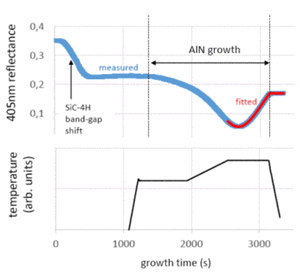- News
1 December 2015
LayTec expands EpiNet library's high-temperature nk database and real-time analysis for GaN/SiC-4H HEMTs
AlGaN/GaN and InAlN/GaN structures combine high electron mobility and high critical electric field strength and are excellent platforms for the production of next-generation RF and power electronics devices such as high-electron-mobility transistors (HEMTs), notes in-situ metrology system maker LayTec AG of Berlin, Germany. Their theoretical nearly three-orders-of-magnitude lower specific on-resistance compared with silicon-based devices could enable an at least 10-fold reduction in power losses, device size and cost, the firm adds.
Typically, the best performance is achieved on semi-insulating silicon carbide (SiC) substrates. However, the metal-organic chemical vapor deposition (MOCVD) growth of the AlGaN and AlInGaN structures on large SiC-4H wafers needs complex growth recipes for strain management and tight statistical process control (SPC) to obtain high process yields. For this technology, LayTec has therefore expanded its high-temperature nk database and implemented additional real-time analysis routines to feed SPC systems with highly accurate in-situ data.
 Picture: AlN buffer growth on SiC-4H in a three-step high-temperature process. The 405nm reflectance data is highly accurate due to auto-calibration to the true SiC-4H substrate temperature (blue – measured; red - fitted reflectance). The fit gives dAlN=73.2±0.5nm. (Data provided by confidential customer.)
Picture: AlN buffer growth on SiC-4H in a three-step high-temperature process. The 405nm reflectance data is highly accurate due to auto-calibration to the true SiC-4H substrate temperature (blue – measured; red - fitted reflectance). The fit gives dAlN=73.2±0.5nm. (Data provided by confidential customer.)
In the example pictured, the initial AlN layer is grown on SiC-4H is performed at very high wafer temperature (measured by Pyro 400 with ±0.5K accuracy) in a sophisticated three-temperature process. This ensures signifiant defect reduction for the subsequent HEMT growth, says LayTec. Despite the varying wafer temperature in this AlN buffer growth process, the latest real-time analysis function of EpiNet library allows the firm's tools to reach ±0.5nm accuracy in real-time AlN fim thickness measurement. This has been achieved by tightly correlating the absolute SiC-4H wafer temperature with high accuracy SiC-4H and AlN nk optical data and implementing new analysis algorithms that separate reflectance changes caused by temperature ramping from the AlN growth effects, says LayTec.
LayTec issues improved n.k database for III-nitrides in EpiNet 2015 release
LayTec Metrology MOCVD AlGaN/GaN HEMTs


